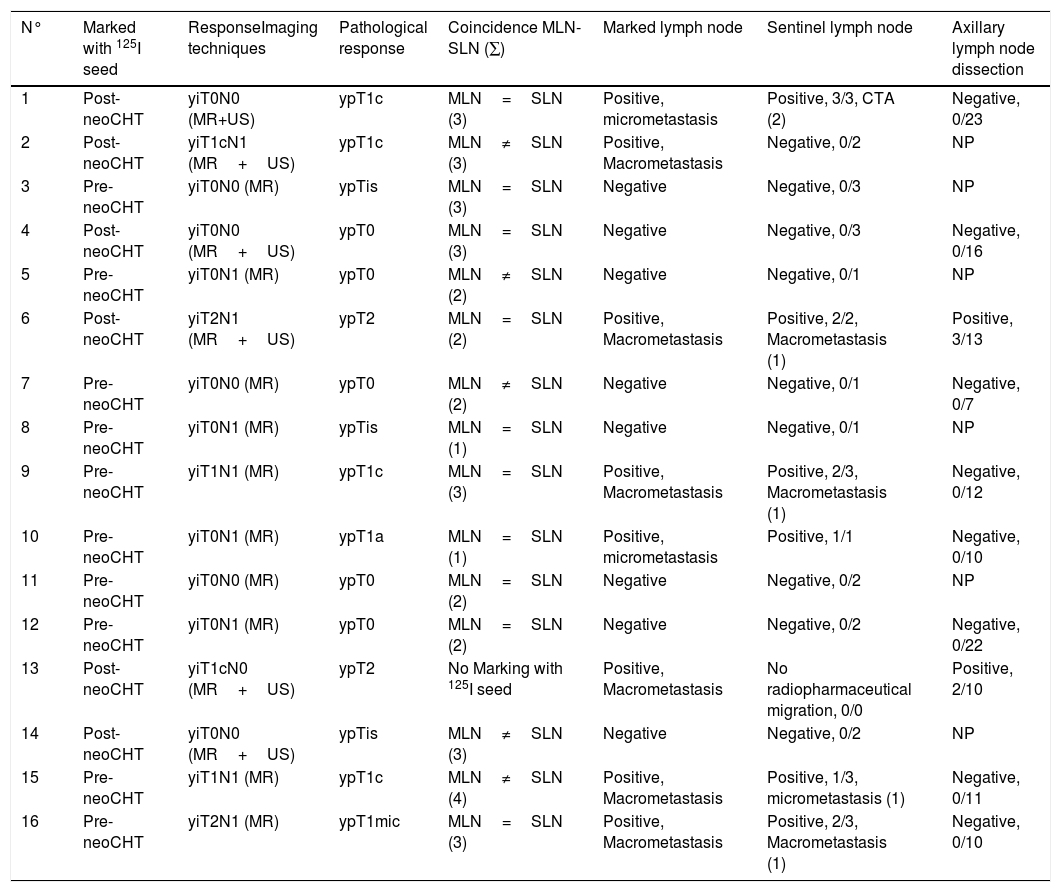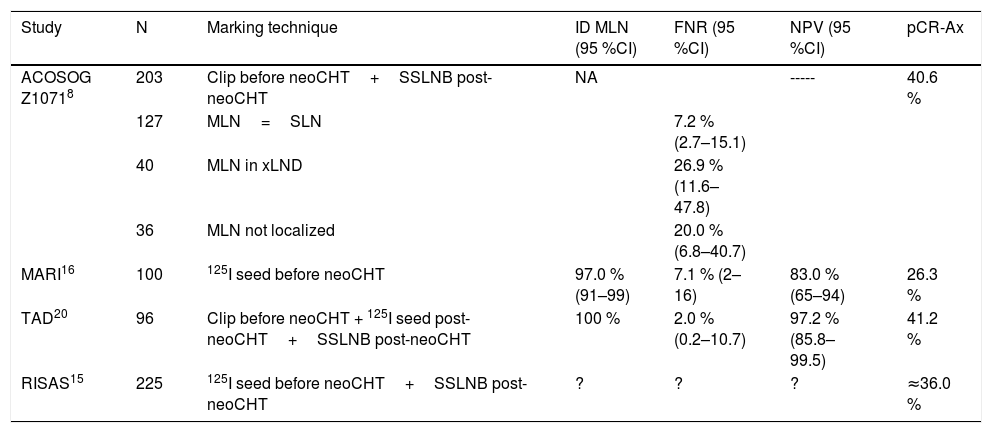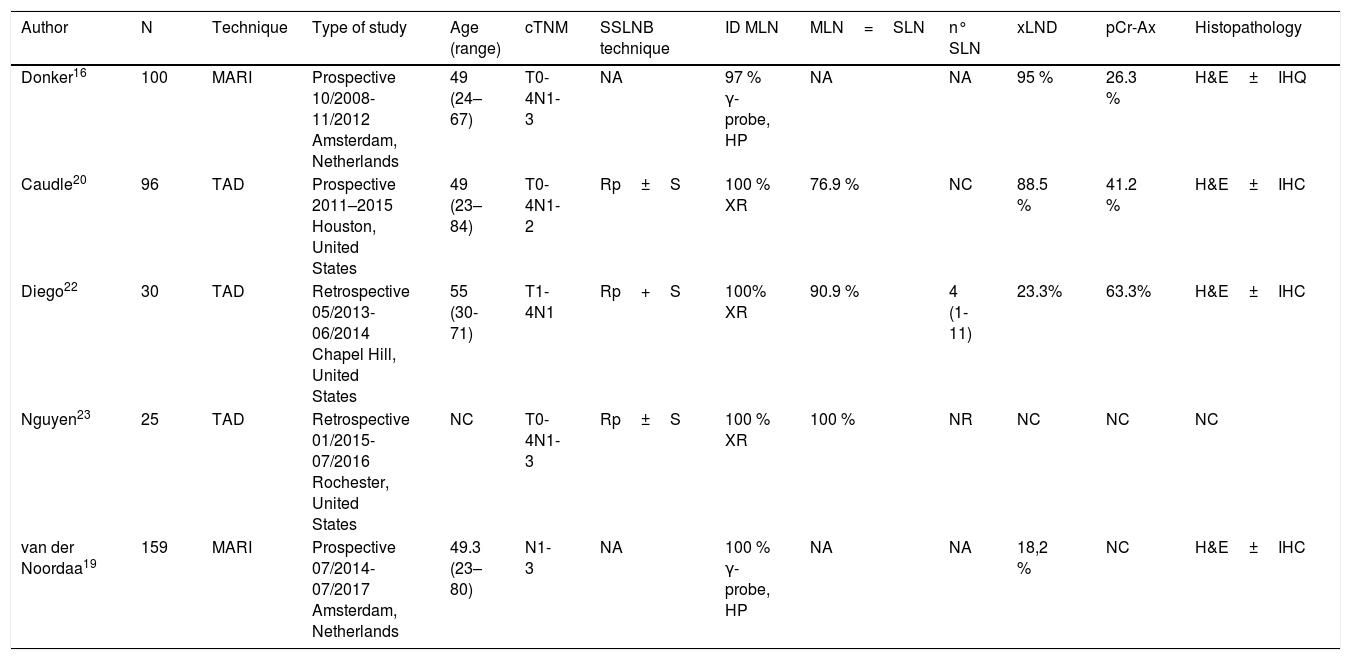Presentar nuestra experiencia inicial en el procedimiento combinado de detección intraoperatoria del ganglio axilar positivo biopsiado marcado con semilla de 125I (GM) y biopsia del ganglio centinela (BGC) después de quimioterapia neoadyuvante (QtNeo), en pacientes con cáncer de mama.
Material y métodosEstudio prospectivo, enero 2017 – marzo 2019, 16 pacientes con cáncer de mama T1-3N1. Estadio TNM: II-A: 3, II-B: 10, III-A: 3. Tipo histológico ductal infiltrante: 14. Subtipos moleculares: luminal-A: 3, luminal-B: 9, HER2: 3, triple negativo: 1.
El GM se marcó 227±36 días antes de iniciar la QtNeo (n: 10), o 1–6 días antes de la cirugía, sobre el ganglio previamente identificado con un marcador ecovisible tipo hidrogel (n: 3) o tridimensional-3D (n: 3). En 10 pacientes se realizó linfadenectomía axilar (LAx).
ResultadosGM y GC se identificaron en la cirugía en el 93,7% (15/16) de los casos, en 33.3 % (5/15) GM no se encontraba entre los GC, y sólo en una enferma (1/5) existió discrepancia entre el resultado de GM y GC (macrometástasis y negativo 0/2). Número medio ganglios GC: 2,2±0,9 (rango 1–3) y LAx: 13,5±5,2 (rango 7–23).
En todos los casos, el análisis anatomopatológico del GM, con semilla de 125I y/o marcador, predijo correctamente el estatus axilar posneoadyuvancia. En todas las pacientes se recuperó la semilla radiactiva de 125I.
ConclusionesLa colocación de semillas de 125I es una técnica factible para la localización intraoperatoria del ganglio positivo biopsiado en combinación con la BGC. El resultado anatomopatológico del GM permite determinar el estatus axilar posneoadyuvancia.
To present our initial experience in the combined procedure of intraoperative detection of axillary positive node marked with 125I seed (ML) and sentinel node biopsy (SLN) after neoadjuvant chemotherapy (NACT), in breast cancer patients.
Material and methodsProspective study, January 2017 – March 2019, 16 breast cancer patients T1-3N1. TNM stage: IIA: 3, IIB: 10, IIIA: 3. Histological type ductal invasive: 14. Molecular subtype: luminal A: 3, luminal B: 9, HER2: 3, basal like: 1.
The ML was marked 227±36 days before NACT (n: 10), or 1–6 days before surgery, on previously identified node by ultrasound visibility marker, hydrogel (n: 3) or three dimensional-3D (n: 3). Axillary lymphadenectomy (AD) was undertaken in 10 patients.
ResultsML and SLN were identified in the surgery in 93.7 % (15/16) of the cases, in 33.3 % (5/15) ML was not among SLN, and in only one patient (1/5) was there a discrepancy between the result of ML and SLN (macrometastases vs. negative 0/2). Median number of lymph nodes SLN: 2.2±0.9 (range 1–3) and AD: 13.5±5.2 (range 7–23). In all cases, histopathological analysis of ML, 125I seed and/or marker within, correctly predicted axillary status after neoadjuvant chemotherapy. In all patients the 125I radioactive seed was recovered.
ConclusionsPlacing of 125I seeds is a feasible technique for intraoperative location of axillary positive node combined with SLN. The histopathological result of ML allows the axillary status to be determined after neoadjuvant chemotherapy.
Article

Revista Española de Medicina Nuclear e Imagen Molecular (English Edition)











